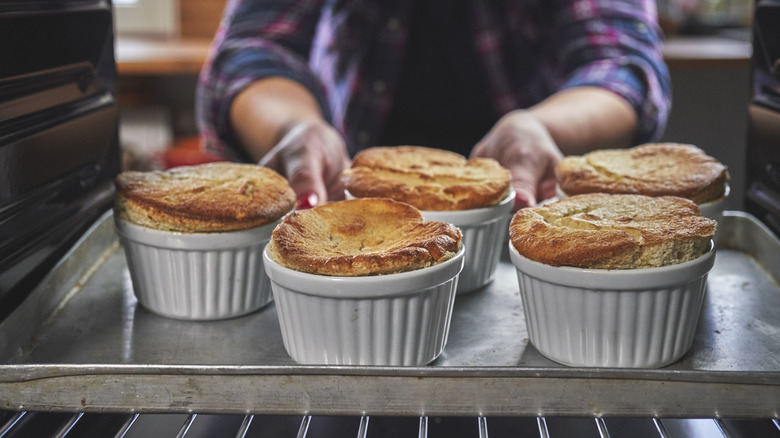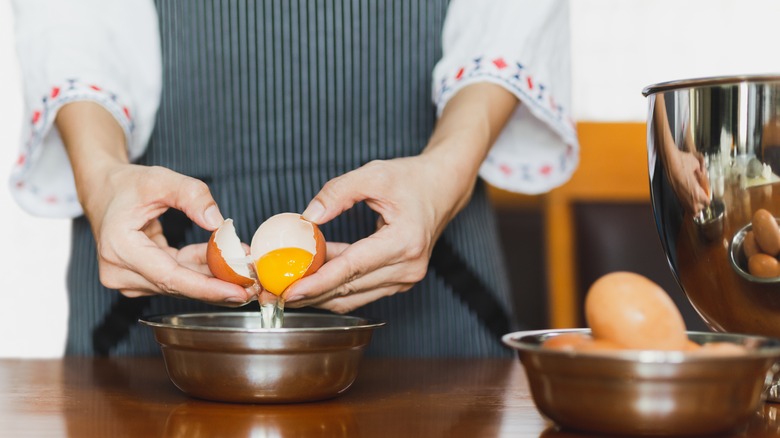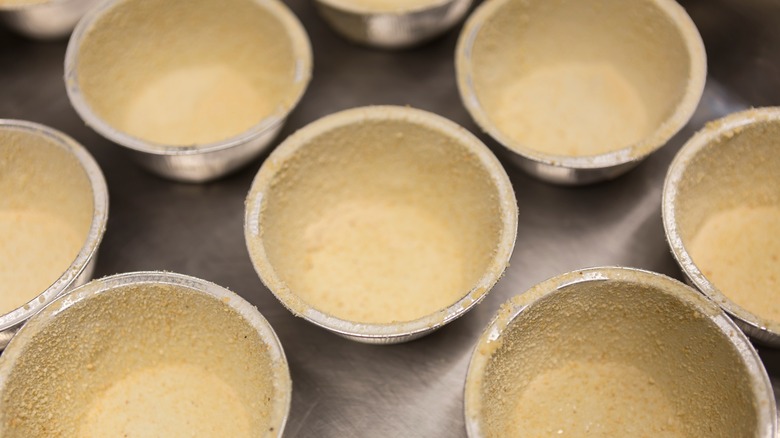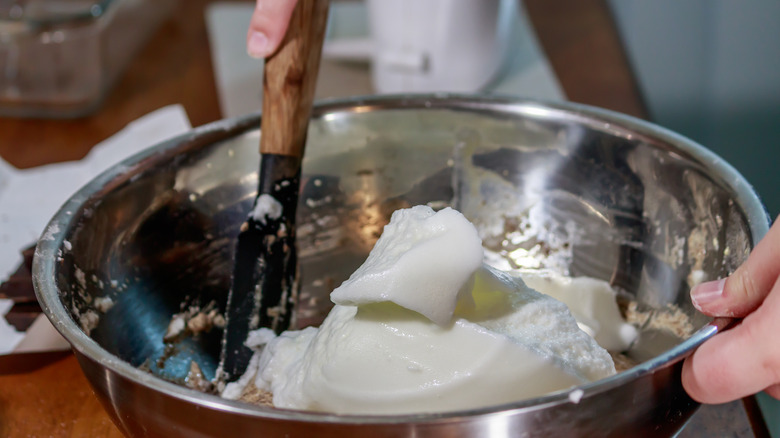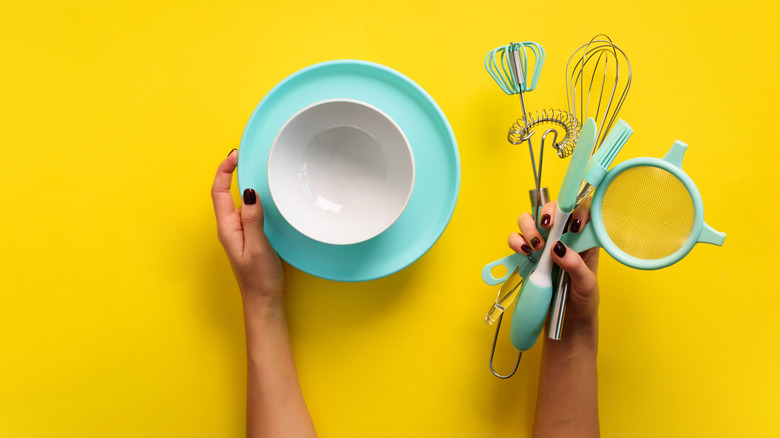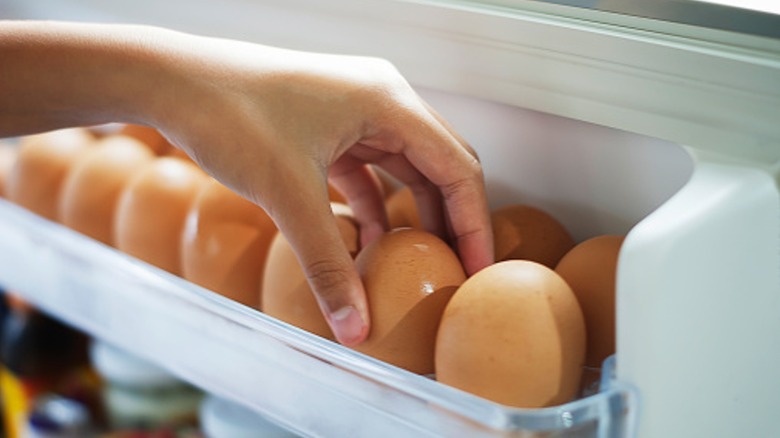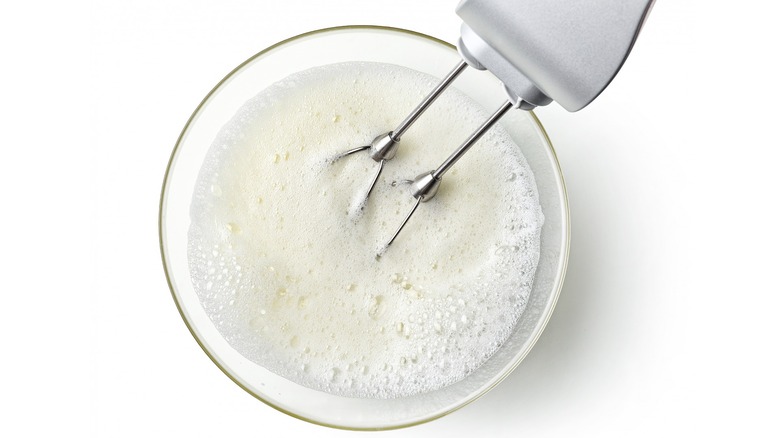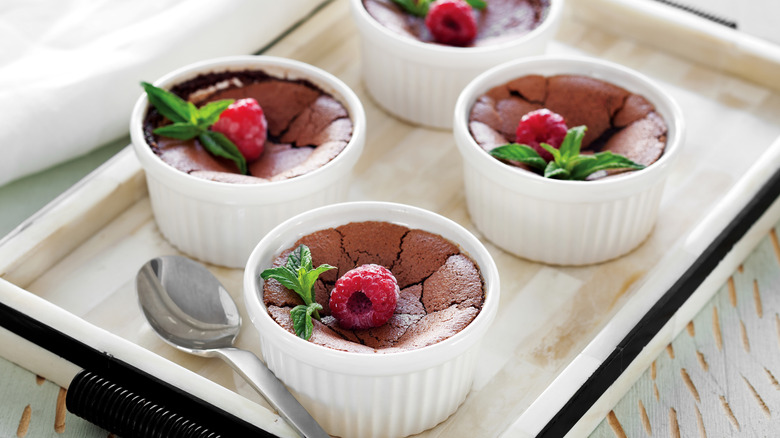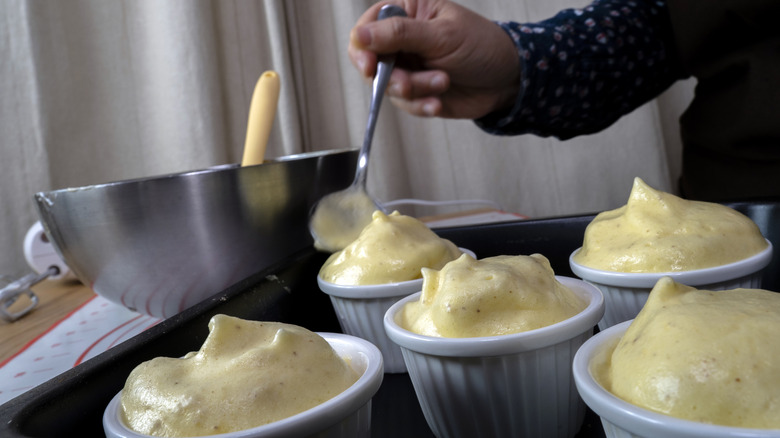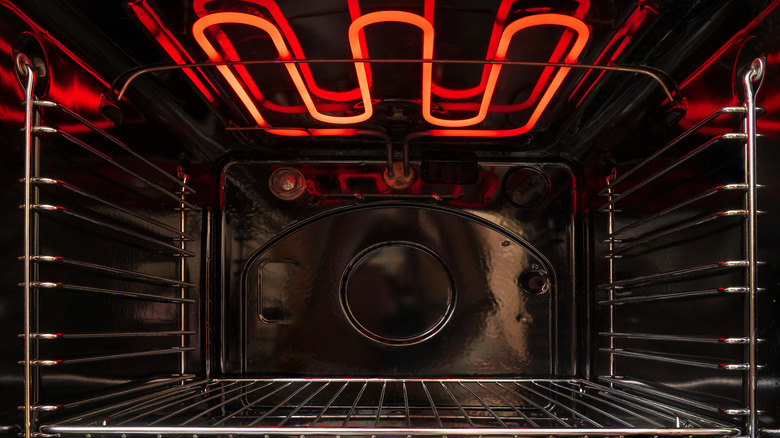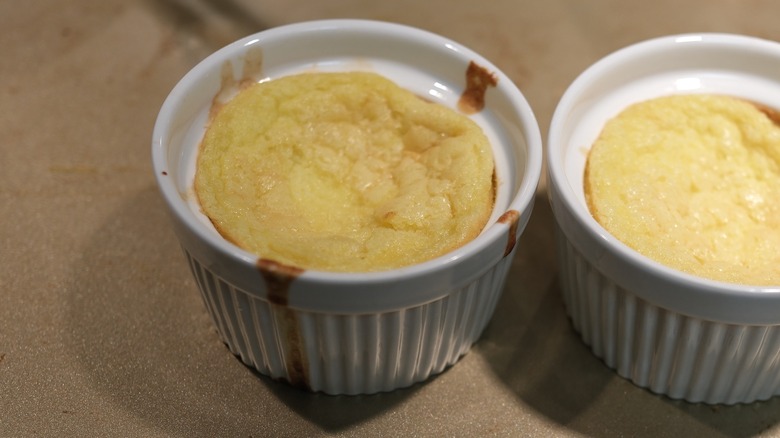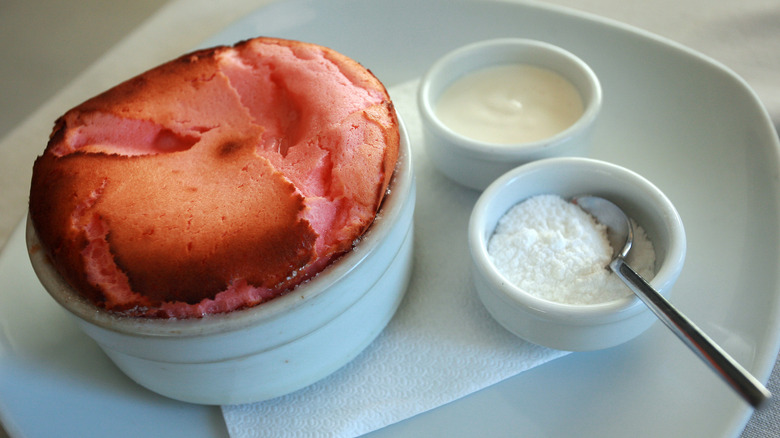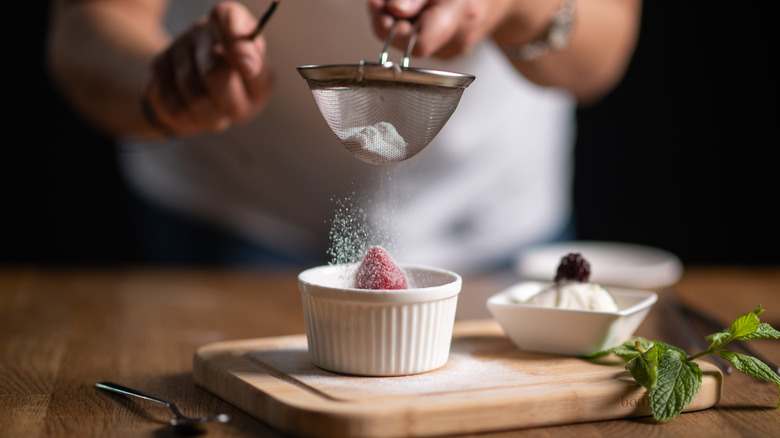13 Mistakes Everyone Makes When Cooking A Soufflé
Many home cooks leave it up to the professionals to make a soufflé, assuming they can never bring the classic recipe to life in the comfort of their homes. This dish indeed demands precision to a degree, but it all depends on how you set yourself up for the task. Unfortunately, if you don't know the process well enough, you might make one of these mistakes that can make or break the final product.
In its simplest form, a soufflé comprises whipped egg whites and a flavored base that you blend to create a fluffy, custard-like dish. There are many things to learn about making a soufflé, from the preparation process to the equipment you use to how you whip the egg whites. But by utilizing proper techniques and exercising caution, you can create a sky-scraping chocolate soufflé or a delicious, savory version instead. Either way, you'll be quite happy with the excellent taste, texture, and appearance of the outcome. And you'll have fun along the way, too.
1. Not practicing first
If you have an important event coming up and want to impress your guests with a dish, you might think a soufflé will do the trick. And it certainly can under certain circumstances. Soufflés are known for being time-consuming and requiring a lot of care, which is why they receive "oohs" and "ahhs" when you serve them. But with all the stress of hosting a party, the last thing you want to do is add more pressure on yourself by trying out a dish you've never made before.
Unless you have mastered the art, making a soufflé for a large group of people is not a good idea, because you need to get the timing down. Don't worry, though, if it's your dream to serve a towering soufflé to your loved ones, it's not impossible. You just need to plan in advance to practice the recipe a couple of times before the event actually takes place.
2. Not preparing the bakeware
We'll let you in on a secret about soufflés: although the whipped egg whites are a big factor in promoting rising, how you prepare the baking dish also plays a huge role. If you only lightly grease the ramekin, or worse, you don't grease it at all, you're doing a massive disservice to yourself.
As preparation, coat the bakeware with butter. Instead of entirely melting the butter, use it while it's still soft, so you can take a pastry brush and brush it vertically up the dish, giving a direction for the batter to follow. Then, coat the bakeware with breadcrumbs, cornmeal, grated parmesan, or granulated sugar. It depends on your specific recipe to determine the best choice, flavor-wise. For instance, with a dessert version, use sugar.
Once these ingredients are added, move the ramekin around to coat it entirely. Tap the sides, dump any excess out, and use these leftover ingredients for the next soufflé. If you're wondering the reasoning behind this method, it is because the batter needs a coarser ingredient to cling onto when it bakes. It prevents it from being flat or lopsided, allowing the batter to easily slide up the bakeware, and giving your soufflé the illusion of defying gravity.
3. Making the batter too far in advance
Unlike other baked foods, like muffins, it can be detrimental to the baking project when you make a soufflé batter days in advance. You can make it a few hours before baking (or even up to 24 hours before). However, you will lose significant lift if you wait any longer than that. The batter is quite delicate due to the beaten egg whites, which lose their fluffiness over time. If you have it in the refrigerator and try to bake it, you'll likely have a not-so-impressive outcome. Although it might still taste good, the presentation won't be up to par.
If you want to get ahead, you can do a couple of things. A day or two before, prepare the ramekins with butter and the desired coating, keeping them in the refrigerator until needed. You can also make the base portion of the recipe and simply hold off from whipping the egg whites. The clock starts ticking when you combine the two to make the complete batter.
4. Using the wrong equipment
Specific tools and equipment are more suitable than others when making a soufflé, and if you use the wrong ones, you might unknowingly ruin the batter. The first step is choosing the right bakeware to cook the soufflé in. Whatever you do, don't use something that's curved or has a ton of divots. Look for a dish with straight sides, so it is easier for the batter to rise. You can purchase special ceramic soufflé dishes or use another type of custard mold. Both family-style and individually portioned dishes work.
Also, plastic mixing bowls are your worst enemy when it comes time to make the batter. They tend to harbor leftover grease, preventing the egg whites from expanding when you whip them. It is much safer to use an easy-to-clean bowl, such as a metal one. Lastly, avoid using a whisk when folding the whites with the base. Although it might seem harmless, a whisk can deflate the mixture, causing you to lose air, which is your primary leavening agent. A spatula gives you more control; try a rubber or silicone one since they can scrape the bowl well.
5. Using cold eggs
Don't grab your eggs from the refrigerator moments before you work on the soufflé; otherwise, the whites don't get as much volume as needed. In general, when they're at room temperature, they expand faster when you mix them. Another bonus with room-temperature eggs is that any yolks you include in the base will easily blend into the other ingredients. So, about 30 minutes before your baking project, take them out of the refrigerator.
Separate the eggs while they're still cold because the yolks don't break as easily at this point. This prevents you from accidentally getting some yolk in the whites, which inhibits them from becoming fluffy. By now, you probably realize how finicky egg whites are, which is why some people shy away from ever trying a recipe like this. Nevertheless, as long as you follow these guidelines, you won't have any issues with the eggs.
6. Underwhipping the egg whites
Since whipped egg whites can greatly impact the outcome of the dish, you must not undermix them. Suppose you are following a recipe to make four individual soufflés. If you only beat the whites to half the required volume, you won't have enough batter to make all four portions when you fill the baking dishes. Not only that, but they don't rise nearly as high when they bake, so they'll have an off texture and disappointing presentation. This is a bummer, but it can be avoided.
You can improve the outcome of your soufflés when you become familiar with what it means to achieve stiff peaks with egg whites. Most recipes require you to bring the whites to this stage because of the stability it offers to the batter. When you whip the whites, check on their texture occasionally. Pull the whisk out of the mixture, and you can see a "peak" at the end of the tool. A soft peak will instantly drop, and a firm peak might slump over, but not as quickly. Meanwhile, a perfect stiff peak holds its shape, indicating that you no longer need to mix it.
7. Not being gentle with the batter
Being especially careful with the batter is one of the secrets to making a successful soufflé. Specifically, one thing you need to be careful about is temperature. Many recipes have you make the sauce portion on the stovetop, which you then combine with the whites. However, if you're not patient and begin to mix the two when it's still hot, it can cook the eggs or make them turn clumpy. To avoid this, allow the sauce to slightly cool first.
Another aspect to consider is the air in the batter because mixing it too vigorously causes it to lose its lightness. Rather than struggling to combine the base and the egg whites — which are different consistencies — add the whites in increments to introduce them slowly. The first addition helps to lighten the other mixture. As a result, the remaining fluffy whites effortlessly fold in. When folding, scrape the underside of the bowl and bring the batter from the bottom to the top. Do this until the mixture is mostly blended and only a few white streaks remain.
8. Adding more ingredients than necessary
Unfortunately, adding too many heavy ingredients to the batter weighs it down, resulting in a dense soufflé. Large chunks of vegetables, meat, or fruit can prevent the batter from rising altogether. Another possible outcome is it might just cause the components to separate. For instance, if you make one with broccoli and don't properly prepare it, the vegetable pieces might sink to the bottom, and the rest of the mixture bakes on top. So, with an intricate egg dish like this, it is better to have a relatively simple recipe.
If you plan to include mix-ins, your best bet is to use a food processor to mince them or to rough chop them by hand into smaller pieces. Carefully fold them into the mixture as the last addition, and get the soufflés to the oven as fast as possible. Lastly, with variations like a cheese soufflé, adding too much cheese or using the wrong type might wreck the batter. High-moisture options create excess water, offsetting the ingredient ratios and negatively affecting the texture. Use shredded (or grated) medium to hard cheese for optimal results, and follow the correct recipe amounts.
9. Filling the ramekins incorrectly
You can't sloppily fill the baking dishes if you plan to create a soufflé with a perfectly flat top and straight sides. It matters how you transfer the mixture to the dish, how high you fill it, and how you adjust it afterward. First, if you underfill it by leaving a ton of extra room, the soufflé doesn't get that dramatic lift everyone loves. On the other hand, if you fill it to where the fluffy mixture exceeds the brim, it spills over when it bakes or becomes domed.
To successfully transfer the batter to the bakeware, carefully scoop it using a large spoon or ladle. This way, you don't accidentally pour it too roughly and make it lose air. Fill it to the edge of the prepared dish, and then take a flat tool such as the backside of a knife and level the mixture out. Most importantly, clean up any batter you might've accidentally gotten on the edge or outside the dish. If you leave it there, it bakes on and burns.
To help aid the soufflé in rising steadily and straight, gently glide the tip of your thumb around the lip of the ramekin, being careful not to remove the sugar or crumb coating. You can also use a clean towel to do so. Once done, there should be a small gap between the top of the batter and the dish, giving it plenty of space to soar.
10. Not thinking about its oven position
Do not make the error of putting your soufflé in an area of the oven that can ruin its presentation or ability to rise. You might have thought you could just pop it in the oven without any problem, but this isn't always true. First, putting it too close to the door might seem like a good idea since you can reach it easier, but this area is often colder. If the soufflé isn't baking at the proper temperature, it takes longer to cook or doesn't turn out right.
Secondly, you don't want to put it too high because the top becomes too dark (or even burns) while the inside is still raw. Therefore, the best spot is toward the middle or lower part of the chamber since the heat from the bottom helps lift the batter.
Additionally, watch out for racks that might be in the way when your soufflé rises. Remove them entirely or adjust them to a higher spot first. And if you plan to make it in a convection oven, don't place it directly in the fan's path because it turns out lopsided or has trouble rising altogether. Although ovens with fans aren't ideal, it is still possible to use them if you're cautious.
11. Opening the oven door while it bakes
Opening the oven door prematurely is one of the most common baking mistakes. It is a bad habit, to say the least, but especially with soufflé. A sudden temperature change can cause fragile baked goods like these to collapse or crack. Undoubtedly, working with an oven that has a window is best since you can examine the soufflé without opening the door. Of course, this isn't feasible for everyone, so if this is the case for you, just try to follow your recipe as closely as possible.
Resist the urge to open the door until the estimated time has passed for the soufflé to be ready. Everything will be fine if you position the bakeware in a good spot and ensure your oven is calibrated beforehand. Honestly, waiting the full amount of time and opening the door to see a fully risen soufflé is much more magical than opening the door every few minutes to check on it, anyway.
12. Undercooking or overcooking it
Soufflés that are underbaked or overbaked often have unpleasant textural and presentation issues. When you use a tried-and-true recipe, the estimated cooking time should be reasonably accurate. Once that time is up, you can use some visual cues to help determine when to remove the soufflé from the oven. Slowly open the oven door and observe its appearance. You're looking for it to nearly double in height and have a golden-brown top. Gently tap the sides of the baking dish to see how the soufflé moves.
If it's ready, it wobbles for a moment but returns to its natural state, meaning it's mostly stable and not liquid. On the contrary, bake it for a few more minutes if it seems soupy or is really shiny on top (serving it this way creates a runny mess). On the other hand, if you forget about it while it is in the oven, it might shrivel up, and the surface has a burnt look, which is, unfortunately, not something you can reverse. Hence, neglecting to set a timer while baking is reckless since it is easy to lose track of time.
13. Waiting too long to serve it
The fleeting delight of a soufflé is part of what makes it so special, and it also means that there are no second chances to serve it. Once you take it out of the oven, you have minutes to bring it to the table before it falls. Therefore, this isn't the dish to procrastinate with. You can't necessarily come up with accompaniments on the fly like you can with other dishes. Otherwise, you end up scrambling around for them, and all your hard work goes to waste.
Imagine chopping fresh strawberries or loading a shaker with powdered sugar when your soufflé is sitting on the side, deteriorating; it's not a pleasant situation. So, while the food is in the oven, take the time to set up the plate or tray you plan to serve it on. Portion the sauce, prepare the napkins, and perform any other prep to set you up for success.
